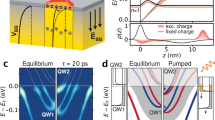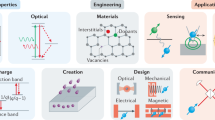Abstract
The ability to control spins in semiconductors is important in a variety of fields, including spintronics and quantum information processing. Due to the potentially fast dephasing times of spins in the solid state1,2,3, spin control operating on the picosecond timescale, or faster, may be necessary. Such speeds—which are not possible to reach with standard electron spin resonance techniques based on microwave sources—can be attained with broadband optical pulses. One promising ultrafast technique uses single broadband pulses detuned from resonance in a three-level Λ system4. This technique is robust against optical-pulse imperfections and does not require a fixed optical reference phase. Here we demonstrate, theoretically and experimentally, the principle of coherent manipulation of spins using this approach. Spin rotations with areas exceeding π/4 for a single pulse and π/2 for two pulses are achieved for donor-bound electrons. This technique might find applications from basic solid-state electron spin resonance spectroscopy to arbitrary single-qubit rotations4,5 and bang–bang control6 for quantum computation.
This is a preview of subscription content, access via your institution
Access options
Subscribe to this journal
Receive 12 print issues and online access
$259.00 per year
only $21.58 per issue
Buy this article
- Purchase on SpringerLink
- Instant access to full article PDF
Prices may be subject to local taxes which are calculated during checkout




Similar content being viewed by others
References
Fu, K. M. C., Santori, C., Stanley, C., Holland, M. C. & Yamamoto, Y. Coherent population trapping of electron spins in a high-purity n-type GaAs semiconductor. Phys. Rev. Lett. 95, 187405 (2005).
Gurudev Dutt, M. V. et al. Ultrafast optical control of electron spin coherence in charged GaAs quantum dots. Phys. Rev. B 74, 125306 (2006).
Titkov, A. N., Safarov, V. I. & Lampel, G. in Physics of Semiconductors (ed. Wilson, B. L. H.) 1031–1034 (Institute of Physics, Bristol, 1978).
Clark, S. M., Fu, K.-M. C., Ladd, T. D. & Yamamoto, Y. Quantum computers based on electron spins controlled by ultrafast off-resonant single optical pulses. Phys. Rev. Lett. 99, 40501 (2007).
Economou, S. E., Sham, L. J., Wu, Y. & Steel, D. G. Proposal for optical u(1) rotations of electron spin trapped in a quantum dot. Phys. Rev. B 74, 205415 (2006).
Viola, L. & Lloyd, S. Dynamical suppression of decoherence in two-state quantum systems. Phys. Rev. A 58, 2733–2744 (1998).
Crooker, S., Awschalom, D., Baumberg, J. J., Flack, F. & Samarth, N. Optical spin resonance and transverse spin relaxation in magnetic semiconductor quantum wells. Phys. Rev. B 56, 7574–7588 (1997).
Ferrio, K. B. & Steel, D. G. Raman quantum beats of interacting excitons. Phys. Rev. Lett. 80, 786–789 (1998).
Gupta, J. A., Knobel, R., Samarth, N. & Awschalom, D. D. Ultrafast manipulation of electron spin coherence. Science 292, 2458–2461 (2001).
Greilich, A. et al. Mode locking of electron spin coherence in singly charged quantum dots. Science 313, 341–345 (2006).
Wu, Y. et al. Selective optical control of electron spin coherence in single charged GaAs–Al0.3Ga0.7As quantum dots. Phys. Rev. Lett. 99, 97402 (2007).
Shen, Y., Goebel, A. M. & Wang, H. Control of quantum beats from electron spin coherence in semiconductor quantum wells. Phys. Rev. B 75, 045341 (2007).
Harris, S. E. Refractive-index control with strong fields. Opt. Lett. 19, 2018–2020 (1994).
Finkman, E., Sturge, M. D. & Bhat, R. Oscillator strength, lifetime, and degeneracy of resonantly excited bound excitons in GaAs. J. Lumin. 35, 235–238 (1986).
Fu, K.-M. C. et al. Millisecond spin-flip times of donor-bound electrons in GaAs. Phys. Rev. B 74, 121304 (2006).
Karasyuk, V. A. et al. Fourier-transform magnetophotoluminescence spectroscopy of donor-bound excitons in GaAs. Phys. Rev. B 49, 16381–16397 (1994).
Piermarocchi, C., Chen, P., Sham, L. J. & Steel, D. G. Optical RKKY interaction between charged semiconductor quantum dots. Phys. Rev. Lett. 89, 16702 (2002).
Paget, D. Optical detection of NMR in high-purity GaAs under optical pumping: Efficient spin-exchange averaging between electronic states. Phys. Rev. B 24, 3776–3793 (1981).
Strauf, S. et al. Quantum optical studies on individual acceptor bound excitons in a semiconductor. Phys. Rev. Lett. 89, 177403 (2002).
Rosatzin, M., Suter, D. & Mlynek, J. Light-shift-induced spin echoes in a j=1/2 atomic ground state. Phys. Rev. A 42, 1839–1841 (1990).
Berezovsky, J., Mikkelson, M. H., Stoltz, N. G., Coldren, L. A. & Awschalom, D. D. Picosecond coherent manipulation of a single electron spin in a quantum dot. Science 320, 349–352 (2008).
Acknowledgements
The authors thank S. Harris and J. Pelc for discussions. S.M.C. was partially supported by the HP Fellowship Program through CIS. This work was financially supported by the MURI Center for Photonic Quantum Information Systems (ARO/ARDA Program DAAD 19-03-1-0199), the JST/SORST Program for the Research of Quantum Information Systems for Which Light is Used, and the University of Tokyo (CINQIE) Special Coordination Funds for Promoting Science and Technology, the “Qubus quantum computer program” MEXT and NICT program on Quantum Repeaters.
Author information
Authors and Affiliations
Contributions
C.R.S. and M.C.H. provided the sample. K-M.C.F and S.M.C. designed, built and carried out the experiment. K-M.C.F. analysed and modelled the experimental data and did the majority of the writing, with significant contributions from S.M.C. S.M.C. contributed the theoretical multiple-small-angle-pulse model. C.S. and Y.Y. contributed throughout the experimental process from the conception to the writing through useful suggestions, comments and discussions.
Corresponding author
Rights and permissions
About this article
Cite this article
Fu, KM., Clark, S., Santori, C. et al. Ultrafast control of donor-bound electron spins with single detuned optical pulses. Nature Phys 4, 780–784 (2008). https://doi.org/10.1038/nphys1052
Received:
Accepted:
Published:
Issue date:
DOI: https://doi.org/10.1038/nphys1052
This article is cited by
-
Quantum photonics with layered 2D materials
Nature Reviews Physics (2022)
-
Ultrafast all-optical coherent control of single silicon vacancy colour centres in diamond
Nature Communications (2016)
-
Advanced optical manipulation of carrier spins in (In,Ga)As quantum dots
Applied Physics B (2016)
-
Cavity-stimulated Raman emission from a single quantum dot spin
Nature Photonics (2014)
-
Complete quantum control of a single quantum dot spin using ultrafast optical pulses
Nature (2008)



